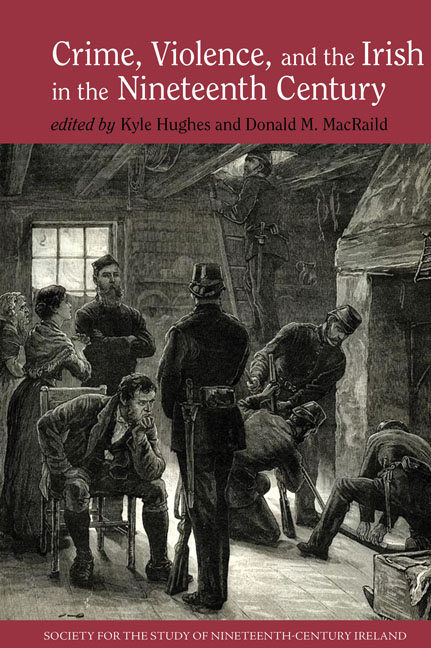Book contents
- Frontmatter
- Contents
- List of Illustrations
- List of Contributors
- Introduction: Crime, Violence, and the Irish in the Nineteenth Century; Themes and Perspectives
- Section 1 ‘Secret Societies’ and Collective Violence
- Section 2 The Law and its Responses
- Section 3 Sectarianism and Violence
- 9 From Bandon to … Bandon: Sectarian Violence in Cork during the Nineteenth Century
- 10 ‘Loyal to the Crown but not the Crown's Government’: The Challenge to Policing Posed by the Orange Order in 1830s Ulster
- Section 4 Manifestations of Crime and Violence
- Index
9 - From Bandon to … Bandon: Sectarian Violence in Cork during the Nineteenth Century
from Section 3 - Sectarianism and Violence
- Frontmatter
- Contents
- List of Illustrations
- List of Contributors
- Introduction: Crime, Violence, and the Irish in the Nineteenth Century; Themes and Perspectives
- Section 1 ‘Secret Societies’ and Collective Violence
- Section 2 The Law and its Responses
- Section 3 Sectarianism and Violence
- 9 From Bandon to … Bandon: Sectarian Violence in Cork during the Nineteenth Century
- 10 ‘Loyal to the Crown but not the Crown's Government’: The Challenge to Policing Posed by the Orange Order in 1830s Ulster
- Section 4 Manifestations of Crime and Violence
- Index
Summary
In his 1989 essay ‘Mass Politics and Sectarian Conflict, 1823–30’, in A New History of Ireland, Sean Connolly wrote that ‘Relations between catholics and protestants in the first two decades of the nineteenth century were strangely mixed in character’. On one hand, the 1790s had revived and strengthened sectarianism, stoked by the rebellion, of course, and subsequent polemical writings from the likes of Sir Richard Musgrave. But this lay side by side with, as Connolly has put it, a ‘considerable degree of tolerance and practical co-operation’. Richard Griffiths, speaking of Cork in 1825, felt that Catholics and Protestants lived in harmony; while Sergeant Lloyd, administrator of the Insurrection Act in Cork, opined that ‘there is a great deal of jealousy between the Catholic peasantry and Protestant peasants’; and Revd Michael Collins, parish priest of Skibbereen, suggested that Protestants in his area ‘betray a consciousness of superiority which operates on the Catholic minds’—‘a perpetual bad feeling exists among them’. In the light of these conflicting viewpoints, how can we interpret sectarian strife in southern Ireland during the nineteenth century?
One explanation of the discordance between the scholar generalising from a mass of evidence and specific contemporary opinion is the significance of the local. It seems that while the sectarian climate was set by reference to the national (and international, even), the sectarian weather is very much a product of local factors. This chapter, then, focuses on Cork city and county, a region containing about 10 per cent of the island's population and land mass. Some prototypical examples of sectarian conflict and violence will be examined, related to the spheres of identity and culture, politics, and religious zealotry, although there is, obviously, considerable overlap between them. The episodes and incidents covered will be Orangeism and aggressive loyalism in Bandon from about 1800 to the 1850s; the 1841 and 1852 elections in Cork city; and, finally, a comparison between the Bible Wars in the 1820s and street preaching in the 1890s. The conclusions will try to place a taxonomy and a structure on sectarian violence, with the objective of attempting some explanation of how and under what conditions it could, and, did, take place—and, maybe more significantly, when it didn't.
- Type
- Chapter
- Information
- Crime, Violence and the Irish in the Nineteenth Century , pp. 175 - 192Publisher: Liverpool University PressPrint publication year: 2017

